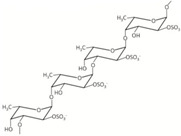Table 3.
Biomaterial passport: fucoidans.
| Scientific Name | Fucoidans |
|---|---|
| Chemical Structure, MW |

|
| Fucoidans are sulphated hetero-polysaccharides consisting of α 1-3 linked sulphated L fucose with repeating sequence of alternating α 1-3 and α 1-4 glycosidic bonds [90,144]. MW of most fucoidans was reported to vary within 200–2000 kDa [145]. | |
| Physicochemical properties | Isolated shielded opposite groups contribute to the solubility of fucoidans in solvents with higher dielectric constants, such as water, whereas solvents of lower dielectric constants, i.e., ethanol can be used for precipitation and isolation of fucoidans from other co-extracted natural compounds [146]. Fucoidan molecules, being stable in salts, i.e., NaCl and CaCl2, acid and alkaline solutions, are suitable for the use as stabilizing, thickening, and water-holding agents [147]. |
| Fucoidan extraction/Physical form after extraction | Fucoidans can be extracted from brown algae such as Undaria pinnatifida (Miyeok), a common Korean edible brown seaweed [148], by hot acidic, alkaline, enzyme-, microwave- and ultrasound-assisted aqueous methods [146]. They are extracted in the form of fluffy, hygroscopic powders, soluble in water, relatively soluble in dimethyl sulfoxide (DMSO), but insoluble in ethanol [146]. |
| Biomaterials properties (biocompatibility, biodegradability, toxicity, immune responses) | Fucoidans have specific mechanical properties. Indeed, these polysaccharides provide mechanical stability to brown seaweeds, in particular, they prevent the desiccation of the thallus tissues, especially at the lower tide levels or high summer temperatures [149]. Fucoidans were reported to be biocompatible, biodegradable and demonstrated low cytotoxicity and immunogenicity [144,150,151,152]. Some studies, however, pointed to their cytotoxicity in vitro and in vivo, which paves the way to their use as anticancer agents [153]. |
| Market situation (world market reports) |
Based on the New Research Analysis, the global fucoidan market size was USD 30 million in 2019 and is expected to reach USD 37 million in 2024 with Asia (mainly China and Japan) and the U.S.A. being the largest fucoidan consumption regions [154]. |
| Patents | Currently, about several hundreds of patents on the extraction and applications of fucoidans exist. |
| For search, use: https://patents.google.com/ | |
| Selected examples: | |
| US20070087996A1. Method of extracting fucoidan | |
| US20100056473A1. Method of extracting fucoidan | |
| CN101993501A. Method for preparing fucoidan | |
| CN103665179A. Extraction device for kelp fucoidan | |
| US20080089941A1. Fucoidan compositions and methods | |
| US20050129708A1. Fucoidan-based health food | |
| CA2253573C. Fucoidan-containing foods or beverages | |
| US20150328268A1. Marine Plants Extract for Wound Healing | |
| CN101954087B. Fucoidan medicinal carrier and preparation method thereof | |
| NZ610788A. Process for isolating fucoidan and laminarin from live, harvested seaweed |
